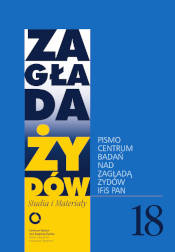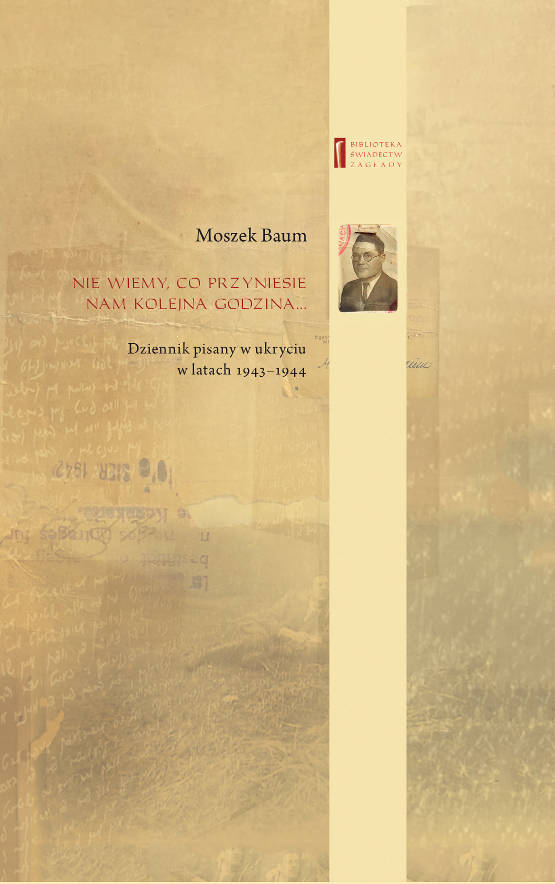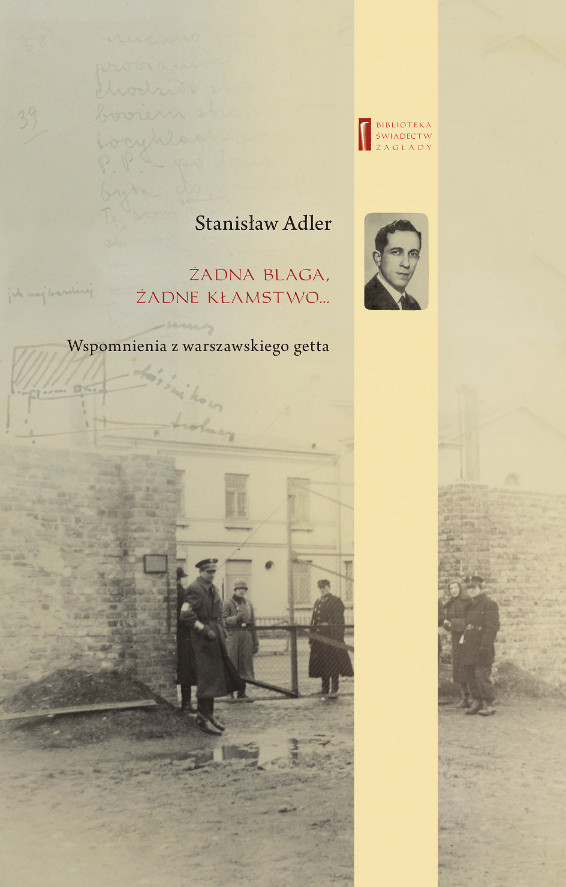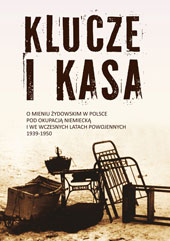Menu
- Strona główna
- Zespół Centrum
- Badania
- Publikacje
- Linki
- Kontakt
- Archiwum
- Zagłada Żydów. Studia i Materiały
pismo naukowe Centrum - Dalej jest noc - »Nieudana KOREKTA OBRAZU«
- Wybór źródeł
- EHRI PL
Aktualności
Otwarte Seminarium Naukowe Centrum: Karolina Koprowska, Rozczarowanie i nadzieja – dwa dyskursy o przyszłości Żydów w powojennej Polsce
Otwarte Seminarium Naukowe Karolina Koprowska "Rozczarowanie i nadzieja – dwa dyskursy o przyszłości Żydów w powojennej Polsce" Spotkanie odbędzie się w środę 10 grudnia br. w sali 161 w Pałacu Staszica (ul. Nowy Świat 72) o godz. 11.00...
Premiera książki Karolin Panz pt. Chciałabym opowiedzieć jak zginęło miasto
10 grudnia o godz. 18.00 zapraszamy do Muzeum POLIN na premierę książki Karoliny Panz pt. "Chciałabym opowiedzieć jak zginęło miasto. Zagłada żydowskich mieszkańców Nowego Targu". Z autorką rozmawiać będzie Anna Bikont Postanowiłam, że odtworzę i opiszę h...
International Summer School
CfP: International Summer School „Innovative Perspectives on Holocaust Research: Sources, Methods, and Digital Tools" UPDATE: NEW DEADLINE: DECEMBER 7, 2025 International Summer School „Innovative Perspectives on Holocaust Research: Sources, Me...
Spotkanie z Michałem Kowalskim wokół sokołowsko-węgrowskiego rozdziału DALEJ JEST NOC
Zapraszamy na spotkanie autorskie z Michałem Kowalskim autorem rozdziału dotyczącego powiatu sokołowsko-węgrowskiego w książce "OTO WIDAĆ i OTO SŁYCHAĆ. Świadkowie Zagłady w okupowanej Polsce" ...
Program seminariów naukowych Centrum na semestr zimowy 2025
Już za niespełna miesiąc wracamy z cyklem seminariów naukowych, na które serdecznie zapraszamy wszystkich zainteresowanych! Seminaria będą się odbywać w drugą lub trzecią środę miesiąca, stacjonarnie w Instytucie Filozofii i Socjologii PAN (ul. Nowy Świat 72, sala 161) ...
NEWSLETTER
 Chciałabym opowiedzieć jak zginęło miasto ...
Chciałabym opowiedzieć jak zginęło miasto ...
Zagłada Żydowskich mieszkańców Nowego Targu
Karolina Panz
Warszawa 2025

 Zagłada Żydów.
Zagłada Żydów.
Studia i Materiały
nr 18, R. 2022
Warszawa 2022
 PAMIĘTNIK
PAMIĘTNIK
Kalman Rotgeber
oprac. Aleksandra Bańkowska, wstęp Jacek Leociak
Warszawa 2021
Zagłada Żydów.
Studia i Materiały
nr 17, R. 2021
Warszawa 2021
 NIE WIEMY CO PRZYNIESIE NAM KOLEJNA GODZINA ...
NIE WIEMY CO PRZYNIESIE NAM KOLEJNA GODZINA ...
Dziennik pisany w ukryciu w latach 1943-1944
Moszek Baum, oprac. Barbara Engelking, tłum. z jidysz Monika Polit
Warszawa 2020
Zagłada Żydów.
Studia i Materiały
nr 16, R. 2020
Warszawa 2020
.jpg) Aryjskiego Żyda wspomnienia, łzy i myśli
Aryjskiego Żyda wspomnienia, łzy i myśli
Zapiski z okupacyjnej Warszawy
Sewek Okonowski, oprac. Marta Janczewska
 PISZĄCY TE SŁOWA JEST PRACOWNIKIEM
PISZĄCY TE SŁOWA JEST PRACOWNIKIEM
GETTOWEJ INSTYTUCJI ...
'z Dziennika' i inne pisma z łódzkiego getta
Józef Zelkowicz, tłum. z jidysz, oprac. i wstęp. Monika Polit
Warszawa 2019
CZYTAJĄC GAZETĘ NIEMIECKĄ ...
Dziennik pisany w ukryciu w Warszawie w latach 1943-1944
Jakub Hochberg, oprac. i wstępem opatrzyła Barbara Engelking
Warszawa 2019
Zagłada Żydów.
Studia i Materiały
nr 15, R. 2019
Warszawa 2019
.jpg) Zagłada Żydów.
Zagłada Żydów.
Studia i Materiały
nr 14, R. 2018
Warszawa 2018
 DALEJ JEST NOC. Losy Żydów w wybranych powiatach okupowanej Polski
DALEJ JEST NOC. Losy Żydów w wybranych powiatach okupowanej Polski
red. i wstęp Barbara Engelking, Jan Grabowski
Warszawa 2018
 ŻADNA BLAGA, ŻADNE KŁAMSTWO ...
ŻADNA BLAGA, ŻADNE KŁAMSTWO ...
Wspomnienia z warszawskiego getta
Stanisław Adler, oprac. i wstępem opatrzyła Marta Janczewska
Warszawa 2018
 Zagłada Żydów.
Zagłada Żydów.
Studia i Materiały
nr 13, R. 2017
Warszawa 2017
 TYLEŚMY JUŻ PRZESZLI ...
TYLEŚMY JUŻ PRZESZLI ...
Dziennik pisany w bunkrze (Żółkiew 1942-1944)
Clara Kramer, oprac. i wstępem opatrzyła Anna Wylegała
Warszawa 2017
 WŚRÓD ZATRUTYCH NOŻY ...
WŚRÓD ZATRUTYCH NOŻY ...
Zapiski z getta i okupowanej Warszawy
Tadeusz Obremski, oprac. i wstępem opatrzyła Agnieszka Haska
Warszawa 2017
 PO WOJNIE, Z POMOCĄ BOŻĄ, JUŻ NIEBAWEM ...
PO WOJNIE, Z POMOCĄ BOŻĄ, JUŻ NIEBAWEM ...
Pisma Kopla i Mirki Piżyców o życiu w getcie i okupowanej Warszawie
oprac. i wstępem opatrzyła Barbara Engelking i Havi Dreifuss
Warszawa 2017
 Zagłada Żydów.
Zagłada Żydów.
Studia i Materiały
nr 12, R. 2016
Warszawa 2016
.jpg) SNY CHOCIAŻ MAMY WSPANIAŁE ...
SNY CHOCIAŻ MAMY WSPANIAŁE ...
Okupacyjne dzienniki Żydów z okolic Mińska Mazowieckiego
oprac. i wstępem opatrzyła Barbara Engelking
Warszawa 2016
 Zagłada Żydów.
Zagłada Żydów.
Studia i Materiały
nr 11, R. 2015
Warszawa 2015
 Mietek Pachter
Mietek Pachter
UMIERAĆ TEŻ TRZEBA UMIEĆ ...
oprac. B. Engelking
Warszawa 2015
 Zagłada Żydów.
Zagłada Żydów.
Studia i Materiały
nr 10, t. I-II, R. 2014
Warszawa 2015
 OCALONY Z ZAGŁADY
OCALONY Z ZAGŁADY
Wspomnienia chłopca z Sokołowa Podlaskiego
tłum. Elżbieta Olender-Dmowska
red .B. Engelking i J. Grabowski
Warszawa 2014
 ZAGŁADA ŻYDÓW. STUDIA I MATERIAŁY
ZAGŁADA ŻYDÓW. STUDIA I MATERIAŁY
vol. 9 R. 2013
Pismo Centrum Badań nad Zagładą Żydów IFiS PAN
Warszawa 2013
 ... TĘSKNOTA NACHODZI NAS JAK CIĘŻKA CHOROBA ...
... TĘSKNOTA NACHODZI NAS JAK CIĘŻKA CHOROBA ...
Korespondencja wojenna rodziny Finkelsztejnów, 1939-1941
oprac. i wstępem opatrzyła Ewa Koźmińska-Frejlak
Warszawa 2012
Raul Hilberg
PAMIĘĆ I POLITYKA. Droga historyka Zagłady
tłum. Jerzy Giebułtowski
Warszawa 2012
 Monika Polit
Monika Polit
"Moja żydowska dusza nie obawia się dnia sądu."
Mordechaj Chaim Rumkowski. Prawda i zmyślenie
Warszawa 2012
.jpg) Dariusz Libionka i Laurence Weinbaum
Dariusz Libionka i Laurence Weinbaum
Bohaterowie, hochsztaplerzy, opisywacze. Wokół Żydowskiego Związku Wojskowego
Warszawa 2011
.jpg) Zagłada Żydów.
Zagłada Żydów.
Studia i Materiały
R. 2011, nr. 7; Warszawa 2011
.jpg) Jan Grabowski
Jan Grabowski
JUDENJAGD. Polowanie na Żydów 1942.1945.
Studium dziejów pewnego powiatu
Warszawa 2011
.jpg) Stanisław Gombiński (Jan Mawult)
Stanisław Gombiński (Jan Mawult)
Wspomnienia policjanta z warszawskiego getta
oprac. i wstęp Marta Janczewska
Warszawa 2010
Holocaust Studies and Materials
Journal of the Polish Center for Holocaust Research
Warssaw 2010
.jpg) Żydów łamiących prawo należy karać śmiercią!
Żydów łamiących prawo należy karać śmiercią!
"Przestępczość" Żydów w Warszawie, 1939-1942
B. Engelking, J. Grabowski
Warszawa 2010
Zagłada Żydów.
Studia i Materiały
R. 2010, nr. 6; Warszawa 2010
Wybór źródeł do nauczania o zagładzie Żydów
Ćwiczenia ze źródłami
red. A. Skibińska, R. Szuchta
Warszawa 2010
.jpg) W Imię Boże!
W Imię Boże!
Cecylia Gruft
oprac. i wstęp Łukasz Biedka
Warszawa 2009
Zagłada Żydów.
Studia i Materiały
R. 2009, nr. 5; Warszawa 2009
.jpg) Żydzi w powstańczej Warszawie
Żydzi w powstańczej Warszawie
Barbara Engelking i Dariusz Libionka
Warszawa 2009
 Reportaże z warszawskiego getta
Reportaże z warszawskiego getta
Perec Opoczyński
Warszawa 2009
 Notatnik
Notatnik
Szmul Rozensztajn
Warszawa 2008
.jpg) Holocaust
Holocaust
Studies and Materials.
English edition
2008, vol. 1; Warsaw 2008
.jpg) Źródła do badań nad zagładą Żydów na okupowanych ziemiach polskich
Źródła do badań nad zagładą Żydów na okupowanych ziemiach polskich
Przewodnik archiwalno-bibliograficzny
Alina Skibińska, wsp. Marta Janczewska, Dariusz Libionka, Witold Mędykowski, Jacek Andrzej Młynarczyk, Jakub Petelewicz, Monika Polit
Warszawa 2007
Zagłada Żydów. Studia i Materiały
R. 2007, nr. 3; Warszawa 2007
Prowincja noc.
Życie i zagłada Żydów w dystrykcie warszawskim
Warszawa 2007
.jpg) Utajone miasto.
Utajone miasto.
Żydzi po 'aryjskiej' stronie Warszawy [1941-1944]
Gunnar S Paulsson
Kraków 2007
 Sprawcy, Ofiary, Świadkowie.
Sprawcy, Ofiary, Świadkowie.
Zagłada Żydów, 1933-1944
Raul Hilberg
Warszawa 2007
Zagłada Żydów. Studia i Materiały
R. 2006, nr. 2; Warszawa 2006
"Jestem Żydem, chcę wejść!".
Hotel Polski w Warszawie, 1943.
Agnieszka Haska
Warszawa 2006
Zagłada Żydów. Studia i Materiały
R. 2005, nr. 1; Warszawa 2005
.jpg) 'Ja tego Żyda znam!'
'Ja tego Żyda znam!'
Szantażowanie Żydów w Warszawie, 1939-1943.
Jan Grabowski
Warszawa 2004
 'Szanowny panie Gistapo!'
'Szanowny panie Gistapo!'
Donosy do władz niemieckich w Warszawie i okolichach, 1940-1941
Barbara Engelking, Warszawa 2003
aaa
ul. Nowy Świat 72, 00-330 Warszawa;
Palac Staszica pok. 120
e-mail: centrum@holocaustresearch.pl
Poland’s dark hunt - MACLEAN'S o anglojęzycznej edycji książki Jana Grabowskiego
Poland’s dark hunt - MACLEAN'S o anglojęzycznej edycji książki Jana Grabowskiego
08.10.2013 10:57:39
Jeden z najważniejszych kanadyjskich tygodników opinii pisze o anglojęzycznej edycji książki J. Grabowskiego "JUDENJAGD. Polowanie na Żydów 1942-1945. Studium dziejów pewneg powiatu" pod tytułem "Hunt for the Jews: Betrayal and Murder in German-Occupied Poland"
![]()
Poland’s dark hunt
New research reveals some Poles were encouraged by the Nazis to actively persecute the Jewish population

There were approximately 3.3 million Jews in Poland before the Germans invaded in September 1939. At the end of the war, that number had plummeted to about 30,000. Now, in path-breaking research, Jan Grabowski, a history professor at the University of Ottawa, reveals what happened to those Jews who tried to hide in rural Poland after the Nazis violently emptied the ghettos. “The locals had everything to say about who could survive and who could not,” he says. In his new book, Hunt for the Jews: Betrayal and Murder in German-Occupied Poland, he explains how, all too often, Poles turned on and killed Jewish neighbours they’d known for decades. And, in particular, he destroys the myth that the Polish “blue” police had nothing to do with killing Jews.
When an earlier Polish version of his book was released in 2011, Grabowski’s findings deeply polarized public opinion in that country. In media interviews and debates, his was the face for a hot-button topic: a re-evaluation of Polish actions during the Holocaust. Poles have long, and rightly, perceived themselves as victims in the Second World War, at the expense of exploring their involvement in the Holocaust. Now, Grabowski says, “You show that, sometimes, victims were victimizing even more desperate people.”
Though his Ph.D. is on New France, an interest in the Holocaust had “always been sleeping in me,” he says, “but woke up in a vengeance” a decade ago while he was visiting his parents in Warsaw. He went to the archives and stumbled upon German court files from the war that hadn’t been opened by historians. Grabowski, whose Jewish father and paternal grandparents survived by “passing” as Poles in Warsaw during the war, began his work.
He focused on one rural county in southeastern Poland, Dabrowa Tarnowska—chosen simply because there is a lot of preserved, archived documentation of what happened there. While the central events of the Holocaust are infamous, little was known about events “at the margins, far away from the factories of death, and far away from historical scrutiny.” What he uncovered was an “in-your-face” Holocaust. “Everything that happened to them was extremely public.”
Before the war, there were 66,678 people in the poor, agrarian county, including 4,807 Jews. While nearly 2,000 were farmers, most lived in town, also called Dabrowa Tarnowska. Unlike urban Jews, who were quickly isolated in ghettos, their rural brethren lived and worked amid the non-Jewish population until just before mid-1942, when they were rounded up in a series of “liquidation actions.”
After the mass deportations to the Belzec extermination camp, only 337 Jews were left. In a meticulously detailed microhistory, Grabowski pieced together their stories by combing survivors’ accounts, as well as records that had never before been examined. Sometimes he found the same event described by Jews, Poles and Germans. Through those historical documents, he discovered that 286 later perished. (While Grabowski’s numbers are precise, he cautions that they are what can be found in historical records. Countless others perished in anonymity.) Only one per cent (51) of the county’s pre-war Jewish population would survive in Dabrowa Tarnowska. That’s because the Nazis’ relentless campaign to slaughter every Jew didn’t stop after the ghettos were emptied. It continued in the form of organized Judenjagd (hunt for the Jews).
While Grabowski expected to find “a degree of treachery, of complacency, of violence,” he found an astounding level of betrayal. Germans needed local help to ferret out the Jews from the scores of small villages. Token rewards were offered to participants—sometimes sugar, often clothes stripped off dead Jews. And to ensure co-operation from even the reluctant, the Germans would demand “hostages” from the villages who would chivvy their neighbours to join. “If the local population did not participate in sufficient numbers in the Jew hunt, then these 10 would be in for a very rough ride,” Grabowski says in an interview.
For the historian, one explanation for widespread involvement in the hunts is a change in attitude: “At a certain point, you see that torture and extermination becomes normal and is getting condoned by the authorities. The Jews were perceived by many—not by all—as no longer entirely human. Once you dehumanize someone, everything becomes much more easy.”
And that meant some Poles began to organize their own hunts. In Hunt for the Jews, the author reveals the untold story of the involvement of the Polish “blue” police. Made up partly of pre-war police, it was the only uniformed, armed Polish police force working under the Nazis, and used its knowledge of the area and networks of informants to track down Jews. Polish doctor Zygmunt Klukowski recorded how, with the SS gone after the liquidations, “today it is the turn of ‘our’ gendarmes and our ‘blue’ policemen, who were told to kill every Jew on the spot. They follow these orders with great joy. Throughout the day, they pulled the Jews from various hideouts” and, after robbing them, “finished them off in plain sight of everyone.”
For peasants who no longer wanted to hide Jews, an option was to hand them over to the blues, who would rob and shoot them before notifying the Germans. In all, while seven Jews were discovered and murdered by Germans alone, Grabowski found 220 who were denounced and/or killed by locals or Polish “blue” police.
It’s the latest chapter in an emotional re-examination of Polish-Jewish relations that exploded into the national consciousness in 2001, when Jan Gross published Neighbors, an account of how Poles in Jedwabne slaughtered their neighbours on July 10, 1941. Gross, a professor at Princeton University, believes public opinion is slowly becoming more open to acknowledging the dark aspects of the war, partly because of the work of Grabowski and others at the Polish Center for Holocaust Studies, established in 2003. “Each time a book came out that dealt with these issues,” says Gross, about his own works, “the debate was shorter and less acrimonious.” Though well received in academia, the Polish version of Grabowski’s book triggered a wave of hate among the nationalist right. The author was even “disinvited for security reasons” from debates.
And interestingly, when a TV crew spent a day in Dabrowa Tarnowska to investigate Grabowski’s findings, they were told of several killings that he’d never heard of, now included in the new English version of his book. Currently, the historian is investigating counties in northeastern Poland. The initial results are “even more depressing,” he reports.
Today, the synagogue of Dabrowa Tarnowska, which was in ruins when Grabowski researched his book, has been restored to its former glory, thanks to European Union money. But it’s too late. There are no longer any Jews in the county.
![]()




.jpg)
.jpg)




.jpg)
.jpg)
.jpg)
.jpg)



.jpg)
.jpg)

.jpg)




